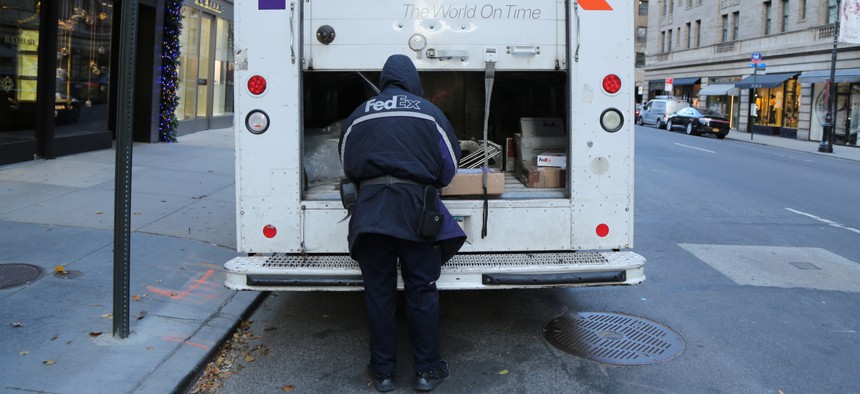The Humble Curb Is Fast Becoming the City’s Hottest Asset

Shutterstock
Digitizing curbs is “something that has benefit today, benefit in the future, and doesn’t require so much investment from cities that they can’t do it today.”
In the city of the future, the ability to get people from point A to point B will be as much about the vehicle as it will be about the curb. Most experts estimate that an average of 30 percent of the traffic in busy urban areas can be accounted for by vehicles searching for places along the curb to pull over. Without a proper place for our future driverless vehicles to drop off passengers, they won’t be able to reduce congestion.
Rather than physically expand curb space, however, a city only needs to create a more sophisticated management system, one that would allow passenger cars to use a curb during the day, for instance, and delivery trucks to use it overnight. This is easier said than done given that cities traditionally manage curb access with physical paper.
Julia Thayne, the director of urban development at Germany’s Siemens, proposes an easy fix for cities to get started: by digitally mapping out all of their curbs, including everything from parking signs to fire hydrants to bike lanes. “This is not big dollars, but it has big benefits,” she says.
Once a city knows the exact location of every curb, it can evaluate its current space allocation against curbside users’ demands. Do cars spend a long time circling the block to find parking? How often are delivery trucks stopping in the middle of a road because there is no loading dock? Armed with that data, the city can more effectively reallocate the curb and implement dynamic management schemes.
D.C.: A Case Study
Only a few cities have begun to digitally map their curbs, and among them, Washington DC is one of the most effective. Instead of attempting to inventory every curb at once, it began with its commercial loading zones to better manage delivery trucks and tackle one of the central causes of congestion.
Prior to digitization, the district had a mismatch in loading zone supply and demand that caused delivery trucks to double-park in car spots or stop to unload in the middle of the street. It was costing the city an estimated $650 million annually, according to the District Department of Transportation, and the problem was likely to get worse. DDOT projected that truck volumes would grow 70 percent from 2011 to 2040. But the city didn’t know where to place new loading zones.
In January 2015 the district inventoried all 600 of its commercial loading zones, digitally mapping them with their corresponding dimensions, signage, and time restrictions, as well as the corresponding number of businesses and business types they served. Using an existing cellphone payment system that charged commercial vehicles, the city also collected loading zone occupancy data, including truck type, number of deliveries, and average length of stay.
The resulting database helped determine where to place additional loading zones and enabled the city to implement demand-based pricingfor their use. In March 2015, DDOT began charging higher prices for specific loading zones during peak hours. The scheme incentivized trucks to deliver overnight, which in turn helped alleviate daytime congestion in busy commercial districts and keep curbsides available to other users. By visualizing the occupancy of loading zones on a public website, the city also allowed inbound truck drivers to save time searching for a place to pull over.
A Vision for the Future
Imagine applying the same digitization process for loading zones to all other curb assets, says Siemens’ Thayne. This would allow cities to dynamically price every vehicle as well as collect data on how often and where each of them uses the curb. Vehicles would know exactly which curb spaces were available—perhaps because that information would be integrated directly into Waze or Google Maps. As a result, the vehicles wouldn’t spend time circling the block, leading to less congestion, better air quality, and even less noise pollution.
In the city of the future, the ability to get people from point A to point B will be as much about the vehicle as it will be about the curb. Most experts estimate that an average of 30 percent of the traffic in busy urban areas can be accounted for by vehicles searching for places along the curb to pull over. Without a proper place for our future driverless vehicles to drop off passengers, they won’t be able to reduce congestion.
Rather than physically expand curb space, however, a city only needs to create a more sophisticated management system, one that would allow passenger cars to use a curb during the day, for instance, and delivery trucks to use it overnight. This is easier said than done given that cities traditionally manage curb access with physical paper.
Julia Thayne, the director of urban development at Germany’s Siemens, proposes an easy fix for cities to get started: by digitally mapping out all of their curbs, including everything from parking signs to fire hydrants to bike lanes. “This is not big dollars, but it has big benefits,” she says.
Once a city knows the exact location of every curb, it can evaluate its current space allocation against curbside users’ demands. Do cars spend a long time circling the block to find parking? How often are delivery trucks stopping in the middle of a road because there is no loading dock? Armed with that data, the city can more effectively reallocate the curb and implement dynamic management schemes.
D.C.: A Case Study
Only a few cities have begun to digitally map their curbs, and among them, Washington, D.C. is one of the most effective. Instead of attempting to inventory every curb at once, it began with its commercial loading zones to better manage delivery trucks and tackle one of the central causes of congestion.
Prior to digitization, the district had a mismatch in loading zone supply and demand that caused delivery trucks to double-park in car spots or stop to unload in the middle of the street. It was costing the city an estimated $650 million annually, according to the District Department of Transportation, and the problem was likely to get worse. DDOT projected that truck volumes would grow 70 percent from 2011 to 2040. But the city didn’t know where to place new loading zones.
In January 2015 the district inventoried all 600 of its commercial loading zones, digitally mapping them with their corresponding dimensions, signage, and time restrictions, as well as the corresponding number of businesses and business types they served. Using an existing cellphone payment system that charged commercial vehicles, the city also collected loading zone occupancy data, including truck type, number of deliveries, and average length of stay.
The resulting database helped determine where to place additional loading zones and enabled the city to implement demand-based pricing for their use. In March 2015, DDOT began charging higher prices for specific loading zones during peak hours. The scheme incentivized trucks to deliver overnight, which in turn helped alleviate daytime congestion in busy commercial districts and keep curbsides available to other users. By visualizing the occupancy of loading zones on a public website, the city also allowed inbound truck drivers to save time searching for a place to pull over.
A Vision for the Future
Imagine applying the same digitization process for loading zones to all other curb assets, says Siemens’ Thayne. This would allow cities to dynamically price every vehicle as well as collect data on how often and where each of them uses the curb. Vehicles would know exactly which curb spaces were available—perhaps because that information would be integrated directly into Waze or Google Maps. As a result, the vehicles wouldn’t spend time circling the block, leading to less congestion, better air quality, and even less noise pollution.
Karen Ho writes for Quartz, where this article was originally published.
NEXT STORY: States embrace benefits of autonomous vehicles





